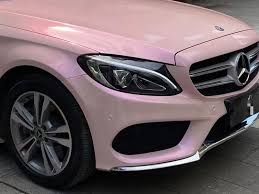Pink Vinyl Wrap vs. Traditional Paint: Which is More Eco-Friendly?

When it comes to customizing the look of your car, two popular options are vinyl wraps and traditional paint. While aesthetics and cost are often the primary considerations, the environmental impact of these choices is becoming an increasingly important factor. So, which is the more eco-friendly option: Pink Vinyl Wrap or traditional paint?
The Environmental Impact of Traditional Paint
Traditional automotive paint involves a multi-step process that includes priming, base coating, and clear coating. While this method provides a durable and glossy finish, it comes with significant environmental drawbacks. Automotive paints often contain volatile organic compounds (VOCs), which are harmful chemicals that evaporate into the atmosphere during application. VOCs contribute to air pollution and can have adverse effects on both human health and the environment.
Additionally, the production and disposal of paint generate waste, including leftover materials and contaminated water used during the painting process. These can pose challenges for proper disposal and recycling, further increasing the ecological footprint.
The Eco-Friendliness of Vinyl Wraps
Vinyl wraps, on the other hand, are made from polyvinyl chloride (PVC), a type of plastic. While PVC itself is not biodegradable, vinyl wraps do have some eco-friendly advantages over traditional paint. For one, the application process for a vinyl wrap does not involve VOC emissions, making it a cleaner alternative in terms of air quality.
Moreover, vinyl wraps can be removed and replaced without damaging the original paint underneath, reducing the need for repainting or additional chemical use. This reusability can extend the life of your car's exterior and minimize waste over time.
However, it's worth noting that vinyl wraps are not without their environmental concerns. The production of PVC involves energy-intensive processes, and improper disposal of wraps can contribute to plastic waste. Recycling options for vinyl wraps are limited, which can offset some of their eco-friendly benefits.
Which Option is Greener?
The answer depends on your priorities. If VOC emissions and air quality are your main concerns, vinyl wraps are generally the greener choice. They offer a lower-impact installation process and avoid the harmful chemicals associated with traditional paint. However, if long-term waste and recyclability are your focus, traditional paint may have an edge due to its durability and fewer concerns about plastic waste.(Green Vehicle Films)
Ultimately, both options have their pros and cons. The most sustainable choice might involve considering alternatives such as water-based paints with low VOCs or exploring companies that offer recyclable vinyl materials. As awareness of environmental issues grows, advancements in both industries may lead to more eco-friendly solutions in the future.
By weighing the environmental impact alongside other factors like cost and durability, you can make a more informed decision about whether a pink vinyl wrap or traditional paint is the best option for your car—and for the planet.








 1
1 2
2 3
3 4
4 5
5 6
6 7
7 8
8